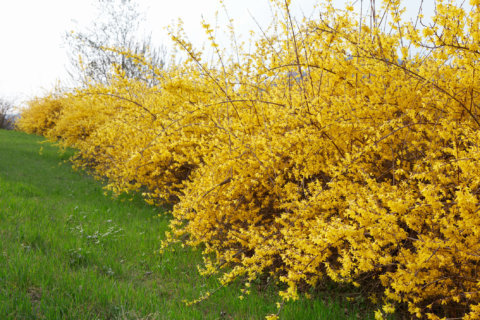Meet Mike next Saturday in Maryland! Mike will appear at 11 a.m., 1 p.m. and 3 p.m. April 28 during the Calvert County Home Show, at the Fairgrounds in Prince Frederick. See details here.
It’s time for me to help you ensure that your spring bulbs — crocus, daffodils, tulips and the like — return reliably next season.
Spring bulb tip No. 1: Sever the seed head
As soon as the flowers fade on tall plants like tulips and daffodils, clip off the seed head that will form prominently at the top of the central stalk to direct all of the plants’ energy into the underground bulb. This is the time of year that next year’s flowers actually form inside the underground bulb, and you don’t want the plants to have any distractions.
And yes, some of those seed heads will be viable, so if you want a long-term project, leave them alone until they discolor a bit (a sign of maturation), then snip, collect and store them indoors in a cool, dry place, plant them outdoors in the fall, and you might get full-size blooming plants … in seven or eight years.
Spring bulb tip No. 2: Leave the leaves
This requires that you do something that many gardeners have a difficult time with — nothing!
OK, you can clip off the seed head that forms at the top of each plant, and you can feed the plants, but you may not mess with the leaves of the plants.
Simple fact: After this year’s flowers fade, the underground bulb grows a new flower inside. And to do that, it needs the rays of the sun on its green leaves aboveground to supply the energy necessary to produce that new flower. Remove the leaves prematurely, and leaves are all you’ll get next spring.
No flowers this year? It’s those darn leaves!
I hope you’re enjoying the wonderful blooms on spring bulbs like tulips and daffodils. They’re some of the brightest stars of the garden this time of year. But some of you may be looking at green leaves without flowers — and that’s because you were hasty with those leaves last spring.
If you remove the leaves of spring bulbs while they’re still green, the underground bulb probably will not have enough energy to produce next year’s flower. I repeat: Hasty removal of the leaves is the single biggest cause of spring bulbs without blooms.
Be patient. You can clip off those leaves as soon as they begin to lose their green. By then, there should be a new flower underground waiting to delight you next year.
Spring bulb tip No. 3: Feed now, not in fall
It’s hard for some gardeners to grasp, but spring bloomers like daffodils, crocus and tulips begin to produce the following year’s flowers deep inside their underground bulb as soon as this year’s flowers fade. Two things you can do to ensure that those future flowers get fully formed:
- Do not remove, tie up or otherwise molest the green leaves of the plants until those leaves lose their color.
- Give the plants a gentle feeding to make sure they have everything necessary to form those flowers. Good choices include compost, compost tea, worm castings or a gentle organic fertilizer — preferably one labeled for bulbs.
Don’t use chemical fertilizer. It can stifle the success of your flowers-to-be. And no matter what, don’t use any fertilizer with double digits representing the N P K levels on the label, like the ridiculous 10-10-10 or explosive 20-20-20. Look for single digit numbers like the 3-5-3 on Espoma’s Organic Bulb-Tone.
Don’t plant flowers overtop of your dormant bulbs
The biggest cause of spring bulbs failing to rebloom is premature removal of their green leaves.
The second biggest cause is planting annual flowers overtop of the area where the underground bulbs are resting. Tulips, daffodils, crocus and the like may have been popularized by breeders in the Netherlands, but the plants themselves are native to some of the most God-forsaken terrain on the planet — mountainous regions of Afghanistan, Russia and Turkey, where pleasant spring weather is followed by fiendishly hot and dry summers.
Watering any plants you position overtop can easily rot the bulbs below. So if you need that space for other things, dig up the bulbs, store them inside and plant them again next fall.







